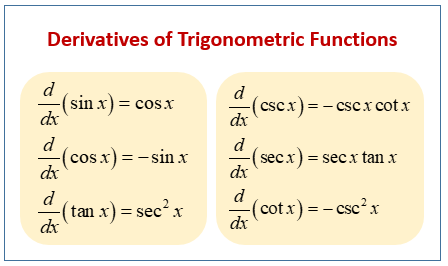Derivatives of Trig Functions: In the realm of mathematics, particularly in calculus, the study of derivatives plays a fundamental role in understanding the behavior and properties of functions. Among the various types of functions encountered, trigonometric functions hold a significant place, given their widespread applicability in describing periodic phenomena and oscillatory behavior. Delving into the derivatives of trigonometric functions unlocks a realm of mathematical elegance and practical utility, offering insights into the rates of change of these functions and their applications in various fields ranging from physics and engineering to finance and beyond.
Table of Contents
Trigonometric Functions

Before delving into derivatives, it is essential to revisit the fundamental trigonometric functions: sine, cosine, tangent, cotangent, secant, and cosecant. These functions, originating from the study of triangles and circles, exhibit periodic behavior and are characterized by specific properties such as amplitude, period, and phase shift. In calculus, these functions serve as essential building blocks for modeling various natural phenomena and analyzing dynamic systems.
Derivatives: Unraveling the Rates of Change
Derivatives of Trig Functions: At the heart of calculus lies the concept of derivatives, which provide a mathematical tool for quantifying the rate of change of a function with respect to its independent variable. The derivative of a function represents its instantaneous rate of change at a specific point and is denoted by the symbol dy/dx or f'(x), where y represents the dependent variable and x the independent variable.
Derivatives of Trig Functions

The derivatives of trig functions exhibit elegant patterns and relationships, which can be derived using fundamental principles of calculus and trigonometry. Let’s explore the derivatives of some common trigonometric functions:
- Derivative of Sine Function (sin x):
Mathematically, it can be expressed as:
[ \frac{d}{dx}(\sin x) = \cos x ] - Derivative of Cosine Function (cos x):
Similarly, the derivative of the cosine function, cos x, with respect to x yields the negative sine function, -sin x:
[ \frac{d}{dx}(\cos x) = -\sin x ] - Derivative of Tangent Function (tan x):
The derivative of the tangent function, tan x, is the secant squared function, sec^2 x:
[ \frac{d}{dx}(\tan x) = \sec^2 x ] - Derivative of Cotangent Function (cot x):
Analogously, the derivative of the cotangent function, cot x, is the negative cosecant squared function, -csc^2 x:
[ \frac{d}{dx}(\cot x) = -\csc^2 x ] - Derivative of Secant Function (sec x):
The derivative of the secant function, sec x, involves the secant function itself and the tangent function:
[ \frac{d}{dx}(\sec x) = \sec x \tan x ] - Derivative of Cosecant Function (csc x):
Finally, the derivative of the cosecant function, csc x, can be expressed in terms of the cosecant function and the cotangent function:
[ \frac{d}{dx}(\csc x) = -\csc x \cot x ]
Derivatives of Trig Functions: These derivative formulas serve as powerful tools for analyzing the behavior of trigonometric functions and their applications in various fields. Whether it’s modeling the motion of waves in physics or analyzing the periodic trends in financial data, a deep understanding of derivatives of trigonometric functions is indispensable.
Applications in Real-World Scenarios:
The derivatives of trig functions find applications across diverse domains, owing to their ability to model periodic phenomena and oscillatory behavior. Here are some real-world scenarios where these concepts are applied:
- Physics: In the study of oscillatory motion, such as the motion of pendulums or waves, trigonometric functions and their derivatives play a crucial role in modeling and analyzing the behavior of these systems.
- Engineering: Engineers often encounter periodic signals and vibrations in mechanical and electrical Derivatives of Trig Functions systems. Understanding the derivatives of trigonometric functions enables them to analyze the frequency, amplitude, and phase of these signals, aiding in the design and optimization of systems.
- Finance: In financial mathematics, trigonometric functions and their derivatives are utilized in the analysis of periodic trends and cycles in market data. Techniques such as Fourier analysis, which decomposes complex signals into simpler sinusoidal components, rely on the derivatives of trigonometric functions.
- Computer Graphics: Trigonometric functions and their derivatives are extensively used in computer graphics for rendering smooth animations and simulating natural phenomena such as light and sound waves.
Derivatives of trig functions represent a fascinating intersection of calculus and trigonometry, offering profound insights into the rates of change of these fundamental mathematical entities. From modeling the motion of celestial bodies to analyzing financial markets, the applications of these concepts are vast and diverse. A solid understanding of derivatives of trigonometric functions not only enhances one’s mathematical prowess but also equips individuals with powerful tools for tackling real-world problems across various disciplines.



